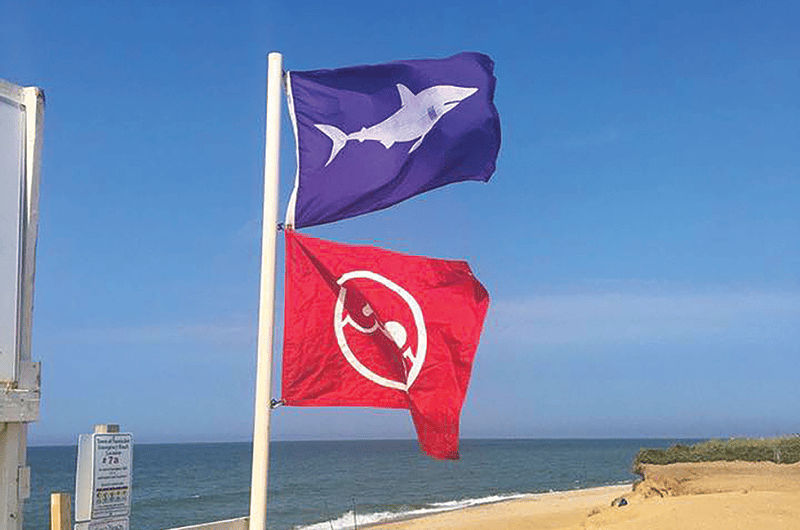by Dr. Sarah Treanor Bois
Director of Research & Education at the Linda Loring Nature Foundation
Do you need a bigger boat or just a different mindset?
Beaches on Nantucket were closed several times this summer for credible shark sightings. Just Google “Nantucket sharks” and any number of videos from various fishing boats and drones pop up. Nantucket’s Topspin fishing charter recently had a show when a great white surfaced, thrashing a seal in its jaws. That’s an experience not soon forgotten.

Aside from missed beach days and big fishing stories, what else should we know about sharing our waters with these ancient creatures?
Sharks are cartilaginous fish a group called elasmobranch, which also includes rays and skates. The earliest known sharks are more than 420 million years old. Most of our modern sharks are traced back to ancestors around a hundred million years ago. Like I said when I wrote about snapping turtles recently: when a creature hasn’t changed much in over a hundred million years, it’s like Mother Nature saying you’re pretty much perfect.
Sharks are apex predators (top of the food chain), and most are carnivores. In our area, we think of sharks eating seals; however, sharks are more than just “Jaws” and other great whites. As such, different shark species eat and are eaten by a diversity of marine life and are an important part of our marine ecosystem.
The most common species of sharks around Nantucket are spiny dogfish, blue shark, basking shark, shortfin mako, porbeagle, threshers, sand tiger sharks, and, of course, the great white shark.
SHARKS IN MASSACHUSETTS
Blue sharks can be up to 10 feet long and feed primarily on fish and squid. Encounters are less likely with these offshore species.
The basking shark is the second largest shark species in the world, growing up to 35 feet in length. These large sharks may seem frightening at first, but they are gentle giants who filter-feed for plankton. They have evolved “ram feeding” where they keep their large mouth open as they swim, eating plankton in their path.
The porbeagle prefers cold water, so it won’t be around this time of year, and it isn’t known to be aggressive. It’s more commonly caught offshore.
Great white sharks want to be where the seals are. Our grey seal populations have had huge increases in the last 15 to 20 years, with an estimated 50,000 seals now off the southeastern coast of Massachusetts. And so the sharks have followed the abundant food source.
Dogfish are the most common shark for people to see and include smooth and spiny dogfish, which are only about three to four feet long. There are usually a few at the Maria Mitchell Association aquarium. Dogfish often frustrate anglers looking for bottom fish, and they easily tangle fishing lines. In the UK, dogfish are the preferred species to use for fish and chips. I wonder if Nantucket will do the same with this currently abundant species?
Another shallow inshore species is the sand tiger shark. Typically nonaggressive sand tiger sharks look worse than their bite, with their sharp protruding teeth.
The common thresher shark is another offshore species. It’s known for its extremely long tail, roughly half its body length, which it uses to strike prey.
The shortfin mako can typically be found 90 to 100 miles offshore. It’s said to be the fastest shark in the sea, surpassing 60 miles an hour.
Our cooler waters limit the encounters with tropical species like hammerheads and tiger sharks. However, as our waters continue to warm, the sharks will go wherever there are feeding opportunities.
SHARKS RESEARCH
With the recent increase in great white shark sightings and human encounters, a lot of science is going into studying behavior of these creatures. Shark biologist Dr. Greg Skomal, senior scientist at Massachusetts Division of Marine Fisheries, has been tagging great white sharks since 2009. The program has now tagged more than a 120 individual great whites. Using the data gathered from these tags, the Atlantic White Shark Conservancy developed the Sharktivity app, which can show users where tagged sharks are in real time and the locations of confirmed shark sightings.
Through this tagging program, we know that great white sharks tagged in Cape waters move broadly throughout the North Atlantic. In the fall, great whites migrate south to overwinter in the Southeastern US and Gulf of Mexico, some moving into the open Atlantic. Many of “our” sharks return to the Cape waters each year.
According to the Massachusetts shark research program, 57 basking sharks have also been tagged since 2004. This tagging program allowed re-searchers to show that the basking sharks cross the Equator and move as far south as Brazil once they leave New England waters.
The Ocearch program uses the latest technology and equipment to help scientists answer big questions about these big fish and provides open source data for the research community. The most recent expedition included 30 scientists from 17 different research projects. In addition to tagging great whites, Ocearch gathers biological samples, makes physical measurements, and attaches more specialized tracking devices. These tasks are only possible because of the unique capture techniques and a hydraulic lift, which takes the sharks out of the water to allow scientists to collect samples. Water continually pumps through its mouth and over its gills during this process. In addition to measurements, samples such as tissue, blood, skin clips, bacteria, and parasites are all collected.
Ocearch also has education and outreach as part of their mission. There are many ways to keep up-to-date with their findings and current research, including their website at ocearch.org.
As waters continue to warm and prey remains available, there will be sharks, including great whites, in the waters around Nantucket. You can still enjoy water activities off the coast, but understand the risks and pay attention to local warnings and beach closures.


